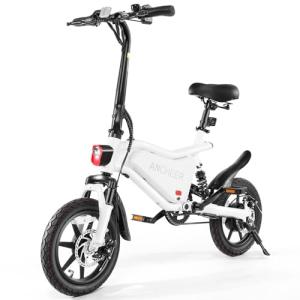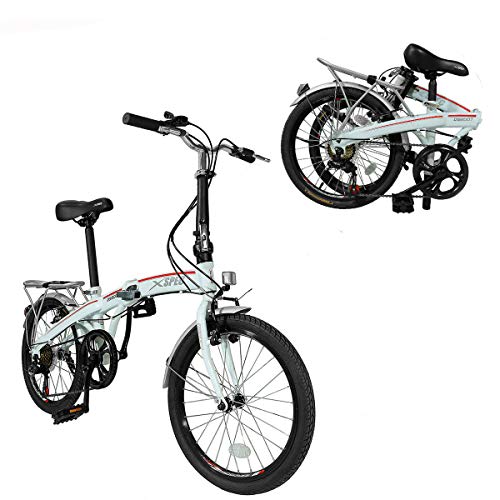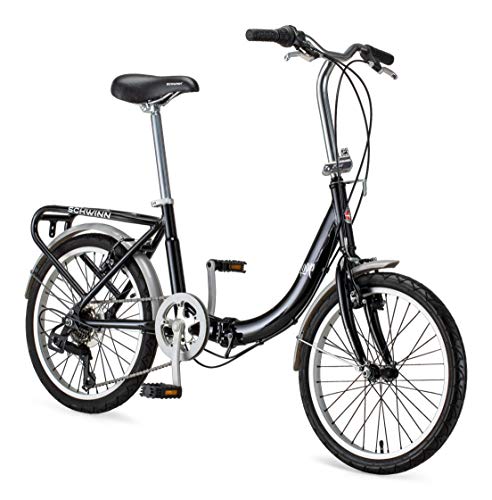Introduction
In recent years, there has been a noticeable surge in the popularity of folding bicycles, marking a significant shift in the way people approach urban mobility and recreational cycling. No longer confined to traditional bike designs, the folding bicycle offers a versatile and compact solution tailored to the needs of modern commuters, urban dwellers, and adventure seekers alike.
The Rising Trend of Folding Bicycles
The rising trend of folding bicycles can be attributed to a confluence of factors, including growing environmental consciousness, urbanization, and advancements in bicycle engineering. As more people seek sustainable and efficient modes of transportation, folding bicycles emerge as a compelling alternative to conventional commuting methods. Their ability to seamlessly integrate with public transportation systems, navigate congested city streets, and adapt to varying terrain has propelled their popularity among commuters seeking flexibility and convenience.
Moreover, the compact nature of folding bicycles addresses the challenges of urban living, where space is often a premium. Whether it's navigating crowded sidewalks, storing bikes in small apartments, or bringing them onto buses and trains, folding bicycles offer a practical solution without compromising on performance or comfort.
Benefits of Owning a Folding Bicycle
Owning a folding bicycle presents a myriad of benefits that cater to the diverse needs and lifestyles of riders. One of the most evident advantages is their portability. Unlike traditional bicycles, folding bikes can be easily folded and carried, making them ideal for multi-modal commuting or stowing away in compact living spaces. This portability extends beyond daily commutes, facilitating effortless travel adventures and exploration, where the convenience of a compact bike becomes indispensable.
Furthermore, folding bicycles offer a level of versatility that transcends traditional cycling. Their ability to adapt to various riding conditions, from urban streets to countryside trails, makes them suitable companions for diverse cycling experiences. Whether it's a leisurely ride through the park, a brisk commute to work, or a weekend getaway, folding bicycles provide riders with the freedom to explore their surroundings on two wheels.
Overview of What to Consider Before Buying
Before diving into the world of folding bicycles, it's essential to consider several key factors to ensure that you make an informed purchasing decision. Firstly, evaluating your specific needs and intended use case will guide you in selecting a folding bike that aligns with your lifestyle and preferences. Whether you prioritize portability, performance, or comfort, understanding your requirements will streamline the selection process.
Additionally, familiarizing yourself with the various features and specifications of folding bicycles will empower you to compare different models effectively. From frame materials and folding mechanisms to wheel sizes and gear ratios, each component plays a crucial role in determining the bike's performance, durability, and overall riding experience.
Lastly, exploring user reviews, seeking recommendations from fellow cyclists, and test-riding different models will provide valuable insights into the real-world performance and suitability of folding bicycles. By taking a comprehensive approach to research and evaluation, you can embark on your folding bike journey with confidence, knowing that you've chosen a two-wheeled companion that meets your needs and exceeds your expectations.
Portability and Size
When considering the purchase of a folding bicycle, one of the primary factors that often takes center stage is portability and size. This section delves into the intricacies of these aspects, providing insights into the importance of compactness, weight considerations, storage options, and the efficiency of folding mechanisms.
Comparison of Folded Sizes among Different Models
Folded size is a critical consideration for anyone seeking a folding bicycle, especially for those living in urban environments or with limited storage space. The compactness of a folded bike determines its ease of transport and storage, making it essential to compare sizes among different models.
Various folding mechanisms result in differing folded sizes. From classic mid-fold designs to innovative triangle-fold configurations, each mechanism offers unique advantages and trade-offs in terms of compactness and ease of folding. Additionally, factors such as wheel size, frame geometry, and handlebar configurations contribute to the overall folded dimensions of a bicycle.
Weight Considerations for Easy Carrying
Alongside folded size, the weight of a folding bicycle significantly impacts its portability and maneuverability. Lightweight materials, such as aluminum and carbon fiber, contribute to a more manageable riding experience, particularly when carrying the bike up stairs, onto public transportation, or storing it in tight spaces.
However, achieving a balance between weight and durability is crucial. While ultra-lightweight bikes may offer unparalleled portability, they could compromise on structural integrity and ride quality. Therefore, it's essential to consider the weight of a folding bicycle in conjunction with its intended use case and the rider's preferences for performance and comfort.
Storage Options: Compactness and Convenience
One of the inherent advantages of folding bicycles is their ability to adapt to various storage scenarios, from cramped apartments to office cubicles and car trunks. The versatility of folding bikes extends beyond their compact folded size to encompass convenient storage solutions that seamlessly integrate into everyday life.
Some folding bicycles feature additional storage accessories, such as carrying bags or racks, further enhancing their portability and convenience. These accessories not only protect the bike during transport but also streamline the process of folding and storing, making it easier for riders to incorporate cycling into their daily routines.
Folding Mechanisms: Quickness and Ease of Use
The efficiency and user-friendliness of a folding mechanism play a pivotal role in the overall experience of owning a folding bicycle. Whether it's a simple hinge system or a sophisticated folding mechanism with multiple locking points, the ease of folding and unfolding directly impacts the bike's practicality and versatility.
Ideally, a folding mechanism should be intuitive to use, allowing riders to fold and unfold their bicycles quickly and without the need for specialized tools or extensive manual dexterity. Additionally, mechanisms that securely lock the bike in its folded position provide peace of mind during transport, ensuring that the bike remains compact and stable throughout the journey.
Performance and Durability
In the realm of folding bicycles, performance and durability are paramount considerations that directly influence the riding experience and long-term satisfaction of riders. This section delves into the intricacies of frame materials, wheel size and handling, braking systems, and gearing and transmission, shedding light on the factors that contribute to a folding bike's performance and resilience.
Frame Materials Strength vs. Weight
The choice of frame material significantly impacts a folding bicycle's performance, durability, and overall riding characteristics. Common materials include aluminum, steel, titanium, and carbon fiber, each offering a unique balance between strength, weight, and ride quality.
Aluminum frames are favored for their lightweight nature and corrosion resistance, making them ideal for urban commuters and recreational riders seeking agility and maneuverability. Steel frames, on the other hand, are renowned for their durability and shock-absorbing properties, providing a smooth and comfortable ride over varied terrain.
Titanium frames strike a balance between lightweight and robustness, appealing to riders who prioritize performance and longevity. Carbon fiber frames, although less common due to their higher cost, offer unparalleled stiffness and responsiveness, translating into a dynamic and efficient riding experience.
Wheel Size and Handling: Balancing Portability with Ride Comfort
Wheel size plays a pivotal role in a folding bicycle's handling characteristics, with smaller wheels typically favored for their compactness and agility in urban environments. However, smaller wheels may sacrifice ride comfort and stability, particularly over rough or uneven surfaces.
Conversely, larger wheels provide enhanced rolling efficiency and stability, making them suitable for longer rides and varied terrain. Folding bicycles with adjustable wheel sizes offer riders the flexibility to customize their riding experience based on their preferences and intended use cases.
Braking Systems: Safety and Reliability
Effective braking systems are essential for ensuring rider safety and confidence, particularly in urban environments with heavy traffic and unpredictable road conditions. Folding bicycles commonly feature rim brakes or disc brakes, each offering unique advantages in terms of stopping power, modulation, and maintenance requirements.
Rim brakes, including caliper brakes and V-brakes, are lightweight and easy to maintain, making them suitable for urban commuting and recreational riding. Disc brakes, whether mechanical or hydraulic, provide superior stopping power and performance, particularly in wet or adverse weather conditions, enhancing rider safety and control.
Gearing and Transmission: Efficiency and Versatility
The gearing and transmission of a folding bicycle play a crucial role in optimizing pedaling efficiency and adapting to varying terrain and riding conditions. Single-speed and internally geared hub systems offer simplicity and low maintenance, making them ideal for urban commuting and casual riding.
For riders seeking greater versatility and performance, external derailleur systems provide a wide range of gear ratios, enabling efficient climbing, acceleration, and cruising speeds. Additionally, electronic shifting systems offer precision and convenience, further enhancing the riding experience for discerning cyclists.
By carefully considering frame materials, wheel size and handling, braking systems, and gearing and transmission options, riders can select a folding bicycle that aligns with their performance expectations, riding preferences, and intended use cases, ensuring years of enjoyable and rewarding cycling experiences.
Comfort and Ergonomics
In the pursuit of an enjoyable and rewarding cycling experience, comfort and ergonomics play a pivotal role, particularly in the design and configuration of folding bicycles. This section explores the importance of adjustable components, suspension systems, riding position, and accessories in enhancing rider comfort and ergonomic efficiency.
Adjustable Components: Saddle, Handlebars, and Stem
Customization is key to achieving optimal comfort on a folding bicycle, and adjustable components such as the saddle, handlebars, and stem offer riders the flexibility to fine-tune their riding position to suit their preferences and body dimensions.
A properly adjusted saddle ensures proper weight distribution and support, reducing the risk of discomfort and fatigue during extended rides. Likewise, adjustable handlebars and stems allow riders to find their ideal riding posture, whether it's an upright position for leisurely cruising or a more aggressive stance for faster-paced riding.
Suspension Systems: Cushioning for Smooth Rides
Suspension systems play a crucial role in absorbing shocks and vibrations from rough road surfaces, enhancing rider comfort and control. While traditional folding bicycles may lack full suspension systems due to their compact design, many models feature front suspension forks or seat post suspension to cushion impacts and smooth out the ride.
The choice of suspension system depends on the rider's preferences and intended use cases. For urban commuters navigating potholed streets and uneven pavement, front suspension provides sufficient comfort and control. For off-road adventures and rough terrain, full suspension systems offer maximum shock absorption and traction.
Riding Position: Balance Between Upright and Aggressive
The riding position of a folding bicycle influences not only rider comfort but also aerodynamics, handling, and overall riding efficiency. Folding bicycles typically offer a choice between an upright riding position, reminiscent of traditional city bikes, and a more aggressive, forward-leaning posture akin to road and performance bikes.
An upright riding position promotes comfort and visibility, making it well-suited for leisurely rides, commuting, and casual cycling. Conversely, a more aggressive riding posture enhances aerodynamics and power transfer, ideal for speed-oriented riding and longer distances.
Accessories for Personalized Comfort: Lights, Fenders, and Racks
Beyond adjustable components and suspension systems, accessories play a crucial role in enhancing rider comfort and convenience on folding bicycles. Integrated lights improve visibility and safety during low-light conditions, while fenders protect riders from splashes and debris, keeping clothing clean and dry.
Additionally, racks and panniers provide ample storage space for commuting essentials, groceries, or recreational gear, reducing the need for backpacks or messenger bags and alleviating strain on the rider's back and shoulders. By outfitting their folding bicycles with the right accessories, riders can create a personalized and comfortable cycling experience tailored to their unique needs and preferences.
Use Cases and Environments
Understanding the diverse use cases and environments in which folding bicycles excel is essential for prospective buyers seeking a versatile and adaptable mode of transportation. This section explores the suitability of folding bicycles for commuting, urban exploration, recreational riding, and traveling, highlighting their convenience and practicality in various scenarios.
Commuting: Seamless Integration with Public Transportation
Folding bicycles are ideally suited for urban commuting, offering commuters a convenient and efficient means of navigating city streets while seamlessly integrating with public transportation systems. Their compact size allows riders to easily fold and carry their bikes onto buses, trains, and subways, eliminating the need for parking and reducing overall commute times.
For urban dwellers faced with congested streets and limited parking options, folding bicycles offer a sustainable and cost-effective alternative to traditional modes of transportation, providing a reliable means of getting to work, running errands, or meeting friends without the hassle of traffic or parking fees.
Urban Exploration: Maneuverability in City Streets
The agility and maneuverability of folding bicycles make them ideal companions for urban exploration, allowing riders to navigate narrow alleyways, crowded sidewalks, and bustling city streets with ease. Whether it's discovering hidden gems, exploring vibrant neighborhoods, or simply enjoying a leisurely ride through the city, folding bicycles provide a versatile and accessible mode of transportation for urban adventurers.
Their compact size enables riders to access areas inaccessible to larger vehicles, such as pedestrian zones, parks, and waterfronts, fostering a deeper connection with the urban environment and encouraging exploration and discovery. Additionally, folding bicycles offer the flexibility to combine cycling with other modes of transportation, such as walking or public transit, further expanding the possibilities for urban exploration.
Recreational Riding: Exploring Parks and Trails
While folding bicycles are renowned for their utility in urban environments, they are equally capable of tackling recreational rides in parks, trails, and scenic routes. Their versatility allows riders to seamlessly transition from city streets to off-road paths, providing a dynamic and engaging riding experience that caters to diverse terrain and landscapes.
Whether it's a leisurely ride along riverfront trails, a scenic tour of local parks, or an adventurous off-road excursion, folding bicycles offer riders the freedom to explore their surroundings and immerse themselves in nature. Their compact size makes them easy to transport to trailheads or recreational areas, eliminating the need for bike racks or specialized vehicles and enabling spontaneous outdoor adventures.
Traveling: Convenient Transportation Option for Trips
For travelers seeking a convenient and eco-friendly mode of transportation, folding bicycles offer a compact and portable solution that enhances mobility and exploration while minimizing environmental impact. Whether embarking on a weekend getaway, a cross-country road trip, or an international adventure, folding bicycles provide travelers with a versatile and accessible means of exploring new destinations.
Their ability to fold down to a fraction of their size makes them easy to transport in cars, RVs, or even as checked luggage on airplanes, eliminating the need for bulky bike racks or expensive shipping fees. Additionally, folding bicycles offer the flexibility to explore destinations at your own pace, whether it's cruising along coastal paths, exploring historic city centers, or discovering hidden gems off the beaten path. By incorporating folding bicycles into their travel plans, adventurers can unlock new opportunities for exploration, discovery, and adventure, creating unforgettable memories along the way.
Budget Considerations
Budget considerations play a significant role in the purchasing decision of a folding bicycle, with options ranging from entry-level models to premium offerings. This section explores the various factors to consider when evaluating folding bicycles across different price points, including affordability, features, performance, and long-term value.
Entry-Level Options: Affordability vs. Features
Entry-level folding bicycles cater to budget-conscious buyers seeking an affordable yet functional transportation solution. These models typically prioritize affordability over advanced features, offering basic components and minimalist designs to keep costs low.
While entry-level folding bicycles may lack some of the bells and whistles found on higher-end models, they still provide a viable means of transportation for urban commuters, casual riders, and recreational cyclists. By compromising on features such as lightweight materials, advanced gearing systems, or suspension components, entry-level folding bicycles offer a cost-effective entry point into the world of folding bike ownership.
Mid-Range Models: Balancing Performance with Price
Mid-range folding bicycles strike a balance between affordability and performance, offering a compelling combination of features, build quality, and riding experience. These models appeal to riders seeking enhanced performance and durability without breaking the bank.
Mid-range folding bicycles often incorporate lightweight materials, such as aluminum or high-quality steel, to achieve a balance between strength and weight. They may also feature upgraded components, such as advanced gearing systems, ergonomic handlebars, and improved suspension systems, to enhance rider comfort and efficiency.
Premium Folding Bicycles: Cutting-Edge Features and Materials
Premium folding bicycles represent the pinnacle of design, innovation, and craftsmanship in the folding bike market. These top-tier models are engineered to deliver exceptional performance, comfort, and versatility, catering to discerning riders who demand the best of the best.
Premium folding bicycles boast cutting-edge features and materials, such as carbon fiber frames, high-performance gearing systems, hydraulic disc brakes, and state-of-the-art suspension components. They are meticulously designed and meticulously engineered to deliver a superior riding experience, whether it's conquering challenging terrain, commuting in style, or embarking on epic adventures.
Long-Term Value: Assessing Maintenance Costs and Resale Value
When evaluating folding bicycles across different price points, it's essential to consider their long-term value in terms of maintenance costs and resale value. While entry-level models may offer initial cost savings, they may require more frequent maintenance and upgrades over time, potentially offsetting any upfront savings.
Mid-range and premium folding bicycles, on the other hand, often feature higher-quality components and construction, resulting in lower maintenance costs and greater durability over the long term. Additionally, these models tend to hold their value better on the resale market, providing owners with a higher return on investment should they choose to upgrade or sell their bikes in the future.
By carefully considering budget considerations and assessing the trade-offs between affordability, features, performance, and long-term value, prospective buyers can make informed decisions when selecting a folding bicycle that meets their needs, preferences, and budget constraints. Whether opting for an entry-level model, a mid-range option, or a premium offering, there's a folding bicycle available for every budget and riding style.
Brand and Model Comparison
Navigating the vast array of folding bicycle brands and models can be daunting for prospective buyers, with each offering its unique features, specifications, and value propositions. This section provides insights into the considerations involved in comparing folding bicycle brands and models, including established brands versus new entrants, customer reviews and feedback, testing and demo rides, and warranty and after-sales support.
Established Brands vs. New Entrants
Established folding bicycle brands bring years of experience, reputation, and brand loyalty to the table, offering riders a sense of reliability, quality, and trust. These brands have established themselves as industry leaders through a track record of innovation, craftsmanship, and customer satisfaction.
On the other hand, new entrants to the folding bicycle market bring fresh perspectives, cutting-edge technologies, and disruptive business models, challenging established norms and pushing the boundaries of design and performance. While new brands may lack the legacy and reputation of established players, they often offer competitive pricing, innovative features, and personalized customer service to differentiate themselves in a crowded market.
Customer Reviews and Feedback
Customer reviews and feedback serve as valuable sources of insight and information for prospective buyers evaluating folding bicycle brands and models. By researching user experiences, opinions, and ratings, riders can gain valuable insights into the real-world performance, durability, and overall satisfaction of various folding bicycles.
Online forums, review websites, and social media platforms provide platforms for cyclists to share their experiences, offer recommendations, and seek advice from fellow riders. By immersing themselves in the cycling community and engaging with other enthusiasts, prospective buyers can make more informed decisions when selecting a folding bicycle that aligns with their needs, preferences, and expectations.
Testing and Demo Rides: Assessing Fit and Feel
Testing and demo rides play a crucial role in the evaluation process, allowing riders to experience firsthand the fit, feel, and performance of different folding bicycle brands and models. Whether it's a quick spin around the block or an extended test ride on varied terrain, demo rides provide valuable insights into the handling, comfort, and ride quality of a folding bicycle.
Many bike shops and retailers offer demo programs or test ride events where riders can sample a range of folding bicycles in a controlled environment. Taking advantage of these opportunities allows riders to assess factors such as frame geometry, handlebar ergonomics, and suspension performance, ensuring that they find a folding bicycle that fits their body and riding style.
Warranty and After-Sales Support
Warranty coverage and after-sales support are essential considerations when evaluating folding bicycle brands and models, providing riders with peace of mind and protection against manufacturing defects and unexpected issues. A comprehensive warranty policy demonstrates a brand's commitment to quality, craftsmanship, and customer satisfaction, instilling confidence in the product and brand.
Additionally, responsive and knowledgeable after-sales support can make a significant difference in the overall ownership experience, whether it's troubleshooting technical issues, providing maintenance advice, or assisting with warranty claims. By choosing a folding bicycle brand that offers reliable warranty coverage and exceptional customer service, riders can enjoy greater confidence and satisfaction in their purchase, knowing that they are supported throughout their ownership journey.
By comparing folding bicycle brands and models across established versus new entrants, customer reviews and feedback, testing and demo rides, and warranty and after-sales support, prospective buyers can make informed decisions when selecting a folding bicycle that meets their needs, preferences, and expectations. Whether prioritizing brand reputation, user experiences, or hands-on testing, there's a folding bicycle available for every rider and riding style.
Sustainability and Environmental Impact
In an era marked by increasing environmental awareness and the urgency to address climate change, sustainability and environmental impact have become critical considerations for consumers across all industries, including cycling. This section explores the sustainability practices of folding bicycle manufacturers, their environmental impact throughout the product lifecycle, and the role of folding bicycles in promoting sustainable transportation choices.
Material Sourcing and Manufacturing Practices
The sustainability of folding bicycles begins with the sourcing of materials and manufacturing processes employed by manufacturers. Sustainable practices encompass the use of recycled materials, responsibly sourced components, and eco-friendly production methods that minimize waste, energy consumption, and environmental impact.
Leading folding bicycle brands prioritize sustainability throughout their supply chains, partnering with suppliers and manufacturers committed to ethical and environmentally conscious practices. By adopting sustainable material sourcing and manufacturing practices, folding bicycle manufacturers reduce their carbon footprint and contribute to the preservation of natural resources and ecosystems.
Energy Efficiency: Impact of Folding Bicycles on Carbon Footprint
Folding bicycles offer a sustainable and energy-efficient mode of transportation that reduces reliance on fossil fuels and minimizes greenhouse gas emissions. Compared to motorized vehicles, folding bicycles require significantly less energy to manufacture, operate, and maintain, making them an environmentally friendly alternative for urban commuting, leisure riding, and recreational activities.
The adoption of folding bicycles as a primary mode of transportation has the potential to significantly reduce carbon emissions, traffic congestion, and air pollution in urban areas. By promoting cycling as a sustainable transportation choice, governments, businesses, and communities can mitigate the environmental impacts of motorized transportation and foster healthier, more livable cities for future generations.
End-of-Life Considerations: Recycling and Disposal
Like all consumer products, folding bicycles have a finite lifespan and eventually reach the end of their usable life. Sustainable disposal practices involve the responsible recycling and disposal of bicycles and their components to minimize environmental impact and maximize resource recovery.
Leading folding bicycle manufacturers design their products with end-of-life considerations in mind, using recyclable materials and components that can be disassembled, reused, or recycled at the end of their lifespan. Additionally, manufacturers may offer take-back programs or recycling initiatives to encourage consumers to dispose of their old bicycles responsibly and ethically.
Promoting Sustainable Transportation Choices
Folding bicycles play a crucial role in promoting sustainable transportation choices and reducing reliance on cars and other motorized vehicles. Their compact size, portability, and versatility make them well-suited for urban commuting, multi-modal transportation, and eco-friendly travel alternatives.
By incorporating folding bicycles into their daily routines, individuals can reduce their carbon footprint, improve air quality, and enhance their overall health and well-being. Furthermore, the widespread adoption of folding bicycles contributes to the creation of more sustainable and resilient cities, where cycling infrastructure is prioritized, and active transportation options are accessible to all residents.
In conclusion, folding bicycles represent a sustainable and environmentally friendly mode of transportation that aligns with the growing demand for eco-conscious mobility solutions. By prioritizing sustainability throughout the product lifecycle, fostering energy-efficient transportation practices, and promoting cycling as a viable alternative to motorized vehicles, folding bicycles contribute to a greener, healthier, and more sustainable future for communities around the world.
Maintenance and Care
Maintaining a folding bicycle in optimal condition is essential for ensuring longevity, performance, and rider safety. This section delves into the best practices for maintenance and care, including cleaning and lubrication, regular inspection, DIY repairs versus professional servicing, and storage tips to protect your investment from the elements.
Cleaning and Lubrication: Prolonging Lifespan and Performance
Regular cleaning and lubrication are fundamental aspects of folding bicycle maintenance, helping to remove dirt, grime, and debris that can compromise performance and accelerate wear and tear. Cleaning your bike after each ride with a mild detergent and water solution helps prevent corrosion and rust, particularly in areas prone to moisture and salt buildup.
After cleaning, applying lubricant to key components such as the chain, derailleurs, and pivot points helps reduce friction, minimize wear, and ensure smooth and efficient operation. Choosing the right lubricant for your riding conditions, whether it's wet or dry, ensures optimal performance and protection against premature component failure.
Regular Inspection: Identifying Wear and Tear
Regular inspection of your folding bicycle is essential for detecting signs of wear and tear, damage, or potential issues before they escalate into more significant problems. Inspecting key components such as the frame, wheels, brakes, and drivetrain ensures that your bike remains safe, reliable, and enjoyable to ride.
During inspections, pay attention to signs of wear such as worn brake pads, loose bolts, frayed cables, or damaged components. Addressing these issues promptly with repairs or replacements helps maintain the integrity and performance of your folding bicycle and reduces the risk of unexpected breakdowns or accidents on the road.
DIY Repairs vs. Professional Servicing
Knowing when to tackle DIY repairs and when to seek professional servicing is essential for maintaining your folding bicycle in top condition. While basic maintenance tasks such as cleaning, lubricating, and adjusting components can often be performed at home with the right tools and knowledge, more complex repairs or issues may require the expertise of a professional bike mechanic.
For routine maintenance and minor repairs, investing in a basic toolkit and familiarizing yourself with common bicycle maintenance procedures can save time and money in the long run. However, for complex issues such as wheel truing, bottom bracket replacement, or hydraulic brake bleeding, it's best to entrust your folding bicycle to a qualified mechanic who has the skills and experience to ensure proper diagnosis and repair.
Storage Tips: Protecting Your Investment from Elements
Proper storage is crucial for protecting your folding bicycle from the elements and prolonging its lifespan. When not in use, store your bike in a dry, sheltered location away from direct sunlight, moisture, and extreme temperatures that can degrade components and accelerate corrosion.
Using a bike cover or storage bag provides an additional layer of protection against dust, debris, and UV exposure, preserving the appearance and condition of your folding bicycle. If storing your bike for an extended period, consider removing the battery (if applicable), releasing tension from the drivetrain, and periodically inspecting and lubricating components to ensure readiness for your next ride.
By following these maintenance and care practices, folding bicycle owners can ensure that their bikes remain in optimal condition for years to come, providing reliable and enjoyable transportation for urban commutes, recreational rides, and adventures. Regular cleaning, lubrication, inspection, and storage are essential habits that contribute to the longevity, performance, and safety of folding bicycles, allowing riders to maximize their investment and enjoyment of cycling.
Conclusion
In the journey of selecting and owning a folding bicycle, a multitude of factors come into play, from portability and performance to sustainability and maintenance. As riders embark on this venture, it's essential to reflect on the key considerations outlined throughout this article, ensuring that each aspect aligns with their needs, preferences, and lifestyle.
With the rising trend of folding bicycles, fueled by their compactness, versatility, and eco-friendly nature, riders have access to a wide range of options catering to diverse use cases and environments. Whether commuting through bustling city streets, exploring scenic trails, or embarking on epic adventures, folding bicycles offer a convenient and sustainable mode of transportation that enriches lives and communities.
As riders navigate the myriad choices available in the folding bicycle market, it's crucial to prioritize factors such as portability, performance, comfort, and sustainability, while also considering budget constraints and long-term value. By conducting thorough research, seeking user feedback, and test-riding different models, riders can make informed decisions that result in a folding bicycle that meets their needs and exceeds their expectations.
Furthermore, ongoing maintenance and care are essential for preserving the integrity and performance of folding bicycles, ensuring longevity and reliability for years to come. By adopting best practices for cleaning, lubrication, inspection, and storage, riders can maximize the lifespan of their bikes and enjoy countless miles of smooth, enjoyable riding.
In conclusion, the decision to purchase a folding bicycle represents more than just acquiring a mode of transportation—it's a commitment to sustainability, health, and adventure. By embracing the versatility, convenience, and eco-friendly nature of folding bicycles, riders can embark on a journey filled with exploration, discovery, and countless memorable experiences on two wheels. Whether navigating city streets, traversing countryside trails, or embarking on cross-country adventures, folding bicycles offer endless possibilities for riders to connect with their surroundings, foster a sense of freedom and independence, and make a positive impact on the world around them.







